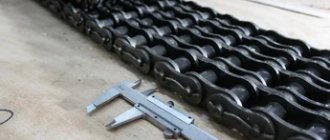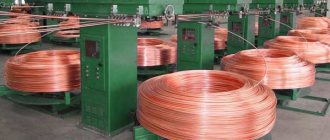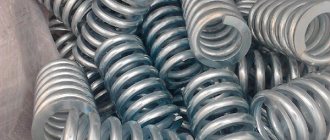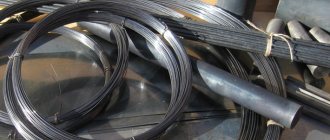Chemical composition
Steel consists of approximately:
- 98% iron,
- 0.2% carbon,
- 0.65% manganese,
- from 0.05 to 0.015% silicon,
- up to 0.3% chromium, nickel and copper combined.
The presence of up to 0.05% sulfur, 0.04% phosphorus and 0.08% arsenic is allowed.
Decoding steel C245
In the designation of steel, the letter C means “construction”, the numbers 245 are the yield strength (T) in megapascals (MPa). In more conventional units σT = 24.5 kg/sq. mm.
Among other parameters characterizing the mechanical properties of steel, we note the tensile strength = 370 MPa (37 kg/sq. mm).
Weldability
To assess weldability, use the criterion of carbon equivalent, calculated by the formula
Se=C+G/6+X/5+(N+D)/15, where C, G, X, N, D – the amount of carbon, manganese, chromium, nickel and copper as a percentage in the composition of the steel or alloy.
For C245, the equivalent carbon is below 0.25%, which means good weldability. The weld seam is not prone to the formation of hot and cold cracks. Parts can be welded by any method without additional measures - preheating, forging the heat-affected zone, etc.
Plastic
Plastic qualities, i.e. the ability to deform in a cold state without signs of destruction, are characterized by the relative elongation of the sample at break and the size of the yield area.
Steel C245 has a relative elongation at break, i.e., the elongation of the sample relative to the initial size after fracture, of 25%.
The length of the yield plateau, i.e. the change in relative elongation at which the stress does not change, is at least 2.5%.
This indicates the possibility of bending and stamping thin sheets of steel. For thick ones, local heating should be used to avoid cracks.
To understand the difference in the deformation capacity of thin and thick sheets, you should refer to the course on strength of materials. When bending a sheet, the difference in changes in the dimensions of the outer and inner sides will be greater, the greater the thickness. This means that for a thick sheet, the relative deformation will be greater and the probability of destruction - the appearance of cracks - will be higher.
With increasing temperature, the yield strength of the metal decreases, and the yield area increases. Therefore, to deform a thick steel sheet, it must be heated or the bend radius increased.
Corrosion resistance
Alloying components—silicon, copper, etc.—slightly increase the corrosion resistance of steels.
C245 has moderate oxidation resistance. It is sufficient for inter-operational storage of workpieces, as well as for operation inside dry rooms without additional protection. In other cases, paint and varnish coatings corresponding to the operating conditions of the structure should be applied.
Standard data for calculations of metal structures:
sheet, wide-band universal and shaped rolled products according to GOST 27772-88 for steel structures of buildings and structures
Notes:
1. The thickness of the shaped steel should be taken as the thickness of the flange (its minimum thickness is 4 mm).
2. The standard values of the yield strength and tensile strength in accordance with GOST 27772-88 are taken as standard resistance.
3. The values of the calculated resistances are obtained by dividing the standard resistances by the reliability factors for the material, rounded to 5 MPa (50 kgf/cm 2 ).
Table 9. Steel grades replaced by steels according to GOST 27772-88 (according to SNiP II-23-81 (1990))
Notes: 1. Steels S345 and S375 of categories 1, 2, 3, 4 according to GOST 27772-88 replace steels of categories 6, 7 and 9, 12, 13 and 15 according to GOST 19281-73* and GOST 19282-73*, respectively. 2. Steels S345K, S390, S390K, S440, S590, S590K according to GOST 27772-88 replace the corresponding steel grades of categories 1-15 according to GOST 19281-73* and GOST 19282-73*, indicated in this table. 3. Replacement of steels in accordance with GOST 27772-88 with steels supplied in accordance with other state all-Union standards and technical conditions is not provided.
Design resistances for steel used for the production of profiled sheets are given separately.
1. SNiP 2.03.01-84 “Concrete and reinforced concrete structures”
3. SNiP II-23-81 (1990) “Steel structures”
4. Aleksandrov A.V. Strength of materials. Moscow: Higher School. — 2003.
5. Fesik S.P. Handbook of Strength of Materials. Kyiv: Budivelnik. — 1982.
For terminals, Yandex Wallet number 410012390761783
For Ukraine - hryvnia card number (Privatbank) 5168 7422 0121 5641
Webmoney wallet: R158114101090
thank you, everything is what we need
Why are the values of the initial modulus of elasticity of concrete during compression and tension multiplied by 10^-3? There must be a positive degree. It turns out that the modulus of elasticity for concrete B25 is 30 kPa, but it is equal to 30 GPa!
Because when compiling various kinds of tables, there is no need to write 3 additional zeros in each cell; it is enough to simply indicate that the table values are underestimated by 1000 times. Accordingly, in order to determine the calculated value, you need to not divide the table value, but multiply it by 1000. This practice is used in the preparation of many regulatory documents (this is the form in which the tables are given) and I see no reason to abandon it.
Then it turns out that the modulus of elasticity of the reinforcement must be divided by 10 to the fifth power. Or am I missing something? In recommendations for the calculation and design of solid floor slabs of large-panel buildings, 1989. and the concrete modulus and the reinforcement modulus are multiplied by 10 to the third and 10 to the fifth power, respectively
I'll try to explain again. Look carefully at Table 1. If in the title line instead of “Elasticity modulus E, MPa” I would write “Elasticity modulus E, MPa•10^-5”, then this would save me from the need to add to the value of the elasticity modulus in each line "•10^5". But the values of elastic moduli for different materials differ hundreds and even thousands of times, so this form of notation for Table 1 is not entirely convenient. In tables 2 and 2.1, the values of the initial elastic moduli differ slightly and therefore this form of notation was used. Moreover, if you open these regulatory documents, you will see this for yourself. This tradition was formed in that distant time when there was no trace of a PC and a typesetter manually typed type into a printing press, so in this case all the questions are not for me, but for Gutenberg and his followers.
Perhaps the modulus of elasticity would be easier to remember and perceive in GPa, because then steel has approximately 200 units, and wood 10.12.
It’s quite possible, but GigaPascals are not the most visual and easy-to-understand dimension.
Note:
Perhaps your question, especially if it concerns structural calculations, will not appear in the general list or will remain unanswered, even if you ask it 20 times in a row. Why is explained in sufficient detail in the article “Make an appointment with a doctor” (link in the header of the site).
Application
Grade C245 is used for the production of sheet and shaped rolled products - equal and unequal angles, channels, T-beams, I-beams. Rolled steel is used in the production of metal structures for various purposes. Due to their good weldability, welded joints are widely used in their production.
Particularly critical structures operating under conditions of constant increased vibration loads are required to be connected with rivets or other methods that prevent the spread of possible cracks.
As analogues of steel grade C245 we can name steel St.3ps, steel St.3sp, which are similar in mechanical properties and chemical composition. It should be noted that a mandatory requirement is the complete or partial completion of deoxidation of steels before the process of casting into molds. This is indicated by the letters ps and sp in the designation of brands.
Low-alloy structural steel C245 has properties that meet the requirements for metal structures for general use.
It can be welded well by all types of welding without additional measures to reduce red and blue brittleness.
The steel has average corrosion resistance. This requires the use of protective paint and varnish coatings for metal structures made from the described steels used outdoors.
Source
Decoding steel
Steel grade C345 belongs to the group of high-strength steel for welded building metal structures. The chemical composition and strength characteristics are regulated by the state standard GOST 27772 of 1988. According to it, the “C345” marking is deciphered as follows:
- Carbon up to 0.15%. For steels, carbon is an integral component along with iron. Its main purpose is to strengthen the metal structure due to the formation of iron carbides. Hardness and strength are directly proportional to the quantitative carbon content in the composition. The other side of the coin of such alloying is a decrease in manufacturability: ductility and weldability.
- Silicon (up to 0.8%) is introduced for deoxidation. It increases the strength of steel while maintaining its toughness value. In addition, this element helps to increase C345’s resistance to scale formation and improves weldability. Alloying with silicon also has a beneficial effect on the elasticity of the alloy.
- Manganese (1.3 -1.7%), like the previous element, belongs to the group of deoxidizers. A small amount of manganese in the alloy has a positive effect on hardness and strength. It is worth noting that such an increase in mechanical characteristics does not in any way affect the ductility of the metal. In addition to all of the above, alloying with manganese gives the alloy greater resistance to impact loads.
These elements, along with iron, are basic for c345. But GOST 27772-88 also allows the inclusion of the following components:
- Nickel (up to 0.3%) increases the alloy’s resistance to corrosion, hardenability and heat resistance.
- Chromium (up to 0.3%) significantly increases the ability of steel to harden under the influence of temperature. Increases the corrosion resistance of metal due to the formation of dense chromium oxides on its surface. Makes steel more resistant to abrasive wear.
- Copper (up to 0.3%) prevents corrosion under the influence of an aggressive environment.
It’s worth mentioning right away that the content of the above elements in c345 is insignificant. For this reason, their influence on properties is not so significant.
Just like any alloy, S345 steel contains harmful impurities. Among them, the most common are sulfur (up to 0.04%), phosphorus (up to 0.035%) and arsenic (0.08%). Their penetration into steel is due to the inaccuracy of the chemical composition of the starting materials - the charge. The error in the temperature regime of the melting equipment also has a significant impact.
A discrepancy between the amount of impurities and the above standards leads to significant losses in metal strength and leads to the formation of an effect such as brittleness. An increase in phosphorus by 0.01% can reduce tensile strength by 25%. Sulfur also increases the susceptibility of steels to red brittleness, i.e., the formation of cracks during hot pressure treatment.
Steel grade C345 has a sufficient number of analogues, both abroad and domestic. Among them, the most common markings are:
The density of c345 is 7850 kgm3. The melting point is about 1550 ºC. A complete transition from solid to liquid is observed at 1620 ºC. Has good thermal conductivity. When the temperature increases by 20 ºC, it expands by 30-40 microns. Poorly conducts electric current. Magnetic
Brand C345 is not characterized by increased resistance to aggressive environmental influences. Reacts with oxygen under normal atmospheric conditions, forming rust. For this reason, it is used in construction after applying moisture-proof coatings to its surface. C345 dissolves in all types of acids and alkalis.
Steel has a low hardness of about 20.24 on the Rockwell scale. Temporary tensile strength - the load at which steel breaks - is 440-470 MPa. The metal begins to deform already at 345 MPa. Quite plastic. The relative elongation at break is 21%.
Steel C345 belongs to the first group of weldability. Welding does not require any preparatory operations: heating the surface, using fluxes, etc. The welds are dense and their strength under compressive load is not inferior to that of solid metal.
The steel is welded using manual arc welding. To prevent overheating, a low current of about 40 A is used. For better adhesion of the edges, the surface of the steel is pre-cleaned before welding.
Not hardened by heat treatment. The reason for this lies in the low carbon content and the lack of sufficient amounts of alloying elements such as chromium.
Steel C245 low carbon
Steel grade C245 represents a class of low-carbon metals. It is designed for the manufacture of a wide range of building structures. Sometimes you can find another marking of this metal, St3ps5. Regardless of the marking given, this steel belongs to the category of so-called semi-quiet steel. Being low-carbon, it belongs to the class of metals of normal strength. This class includes the entire range of steels from C235 to C285.
Standard data for calculations of reinforced concrete structures:
Table 2.1. Initial elastic moduli of concrete according to SNiP 2.03.01-84*(1996)
Notes: 1. Above the line the values are indicated in MPa, below the line - in kgf/cm2.
2. For lightweight, cellular and porous concrete at intermediate values of concrete density, the initial elastic moduli are taken by linear interpolation.
3. For non-autoclaved cellular concrete, the Eb values are taken as for autoclaved concrete, multiplied by a factor of 0.8.
4. For prestressing concrete, the values of Eb are taken as for heavy concrete, multiplied by the coefficient a = 0.56 + 0.006B.
5. The concrete grades given in brackets do not exactly correspond to the specified classes of concrete.
Main characteristics of construction steel grade C245
In terms of chemical composition, it includes the following set of basic chemical elements:
- iron – close to 98%;
- carbon does not exceed 0.22% (therefore it belongs to the class of low-carbon steels);
- manganese no more than 0.65%;
- nickel about 0.3%;
- chromium and copper, also about 0.3%.
Other elements, such as silicon, sulfur, phosphorus do not exceed one hundredth of a percent. Steel S245 complies with GOST 27772-88.
In accordance with established standards, steel grades are deciphered as follows. It has a general letter and individual digital marking. For example, C245 the letter “C” means that it is a construction metal, and the three-digit number 245 indicates the yield strength.
Explanation of rental symbols
The addition of individual chemical elements improves certain characteristics of the metal. For example, adding chromium or nickel increases hardness and improves anti-corrosion properties. The presence of copper in the alloy increases toughness and improves thermal conductivity. The presence of elements such as manganese and silicon prevents the formation of ferrous oxide. Manganese eliminates the negative effects of sulfur, which makes the metal brittle. The addition of alloying elements significantly increases the hardness of the product and improves its anti-corrosion properties.
In accordance with this chemical composition, all products have the following physical characteristics:
- coefficient of thermal expansion;
- thermal conductivity coefficient or heat capacity of the material;
- specific heat;
- the density for almost all samples is the same and amounts to 7850 kg/m 3 ;
- modulus of elasticity of the first kind;
- electrical resistivity;
All of the listed characteristics are determined by the temperature at which the tests took place. This is necessary to assess the possibilities of future operation of the products.
Mechanical properties of steel 245
Since it is produced in the form of sheet or shaped rolled products, the mechanical properties are considered for each type separately. The main mechanical properties include:
- short-term strength limit (for sheet metal from 2 to 10 millimeters is equal to 370 MPa);
- yield or proportionality limit (for a sheet it has a value of 245 MPa);
- relative elongation at break (sheets from 2 to 4 millimeters is 20%, for sheets up to 10 millimeters 25%);
- the amount of bending until the sides are parallel (defined as the diameter of the possible rounding and depends on the thickness of the metal);
- impact strength – varies from 29 to 39 J/cm2 depending on the ambient temperature;
- hardness (comparison is made according to various criteria, for example Brinell, Vickers or Shore) according to Brinell is 131 MPa.
Technical characteristics: subtleties of using reference manuals
GOST 30246-94 rolled thin sheets with protective and decorative paint coating for building structures.
technical specifications The properties of 09g2s steel are largely determined by the chemical composition of the alloy, its specific parameters, which today are quite accurately calculated by metallurgists.
Steel grade 09g2s has the following critical points:
- Ac1 = "" 732, when austenite transforms into pearlite during cooling processes;
- Ac3(Acm) =»» 870 (s – from French chauffage/heating) the end point of cementite dissolution;
- Ar3(Arcm) =»» 854 (refro >Classical symbols, numbers 1 and 3 indicate the numbers of points on the graph. Symbols cm usually mark hypereutectoid steels.
If we talk about other features of St 09g2s, the following characteristics are noted: easy weldability of the material. For this purpose, RDS, ADS under flux and gas protection are used. Only products that have undergone chemical-thermal treatment cannot be welded.
The mechanical properties of steel 09g2s are tabular values that were developed by a number of GOST standards and describe the material at room temperature, as well as for its other states.
Among the important mechanical properties of 09g2s steel are the following:
- Yield strength for permanent deformation, measured in MPa;
- Relative values of elongation at break and contraction;
- Impact strength (use under load is one of the main applications);
- Brinell hardness (HB).
Strength class of steel 09g2s: the table for the list of grades includes the one indicated, which, as already noted, corresponds to C345. This also includes a number of other brands. Thus, steels that are different in chemical composition and even in the method of producing steel can have the same strength class. This data can be found for 09g2s according to GOST 19281-2014; the characteristics of the alloys are presented in convenient tables that are easy to navigate. You can view (download) GOST 19281-2014 here.
But the opposite situation is also possible. For example, for 09g2s GOST 19281-89 and grade 16GS there is data on strength classes 265 and 296.
The same GOST describes the types of rolled metal:
- Varietal, round, shaped with various sections (including circle 09g2s).
- Wideband profiles with a certain thickness of products.
Read also: How to weave a fishing net with your own hands
Large diameter circles steel 09g2s
Similar information is provided for other brands.
The density of steel 09g2s fluctuates, somewhere around the mark of 7800 kg/m 3. But alloying elements can either increase the specific gravity or reduce it. Tungsten tends to be the first. The second is achieved by adding: cobalt, nickel, copper.
The hardness of steel 09g2s can be determined by Brinell, Rockwell, Vickers, etc. the choice of system is determined by the type of products for which parameter determination is required. It is also important when choosing a welding method; the hardness of the steel at the weld should remain fairly high.
Most of the listed parameters can be found in TU 14 3 1128 2000 for steel 09g2s, as well as for other grades. The technical specifications describe the requirements for the materials from which pipes are made for servicing gas fields and other areas of the industry.
The permissible stress for steel 09g2s is calculated depending on the following values:
- strength class and grade;
- temperatures at which it will be operated;
- thickness, sometimes configurations (circle, sheet, etc.).
Existing 09g2s analogues are foreign (European, Asian, others), most similar in mechanical and technical properties to the specified brand. However, the chemical composition can vary greatly. The Bulgarian version of this brand has the closest configuration.
Advantages and scope
All of the listed properties make it possible to successfully use C245 for the production of rolled metal, which is used for the construction of various building structures. The basic requirements imposed on C235 and C275 are similar to those imposed on C245. Its inherent strength, the main indicator is the so-called yield strength, is quite sufficient for the formation of elements capable of withstanding heavy loads. The main difference between hot-rolled steel C235 is its use for the production of auxiliary building structures.
Character traits
When C345 is exposed to a temperature of 20 °C, the steel is endowed with a short-term strength of 490 MPa, a fluidity of 345 MPa and an elongation at break of 15%. And the thicker the alloy, the lower these indicators will be. However, the elongation will increase to 21%. Rolled metal itself can be produced in 4 classifications, each of which has certain test indications: 1st and 3rd have impact strength at T = -40 °C, but at T = -70 °C such properties disappear. The 2nd and 4th categories are endowed with opposite indicators. As for viscosity after mechanical aging, they can only be observed in grades 4 and 3 of steel.
Properties of steel C345
Such characteristics make it possible to produce complex building structures that can withstand extreme loads. The lowest alloy ingot can be used to make fences and enclosures of any size, water pipes for various liquids, tanks for storing emulsions and other products for typical applications. Also, due to its resistance to aggressive factors, steel is often used in mechanical engineering to create elements of cranes, rails, and power line supports.






